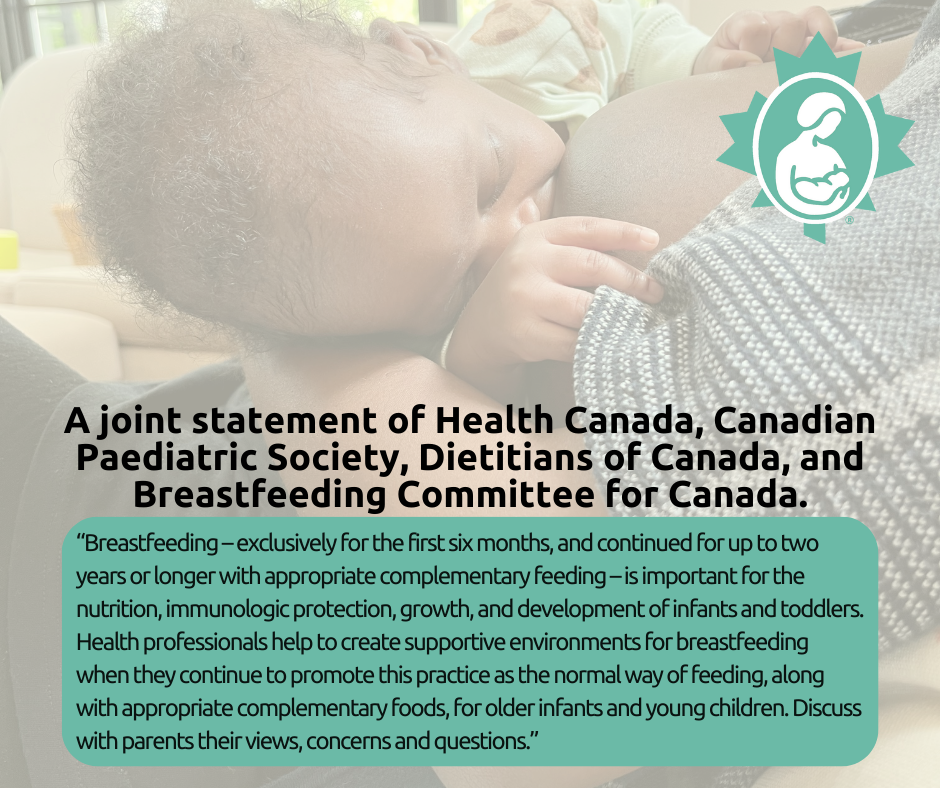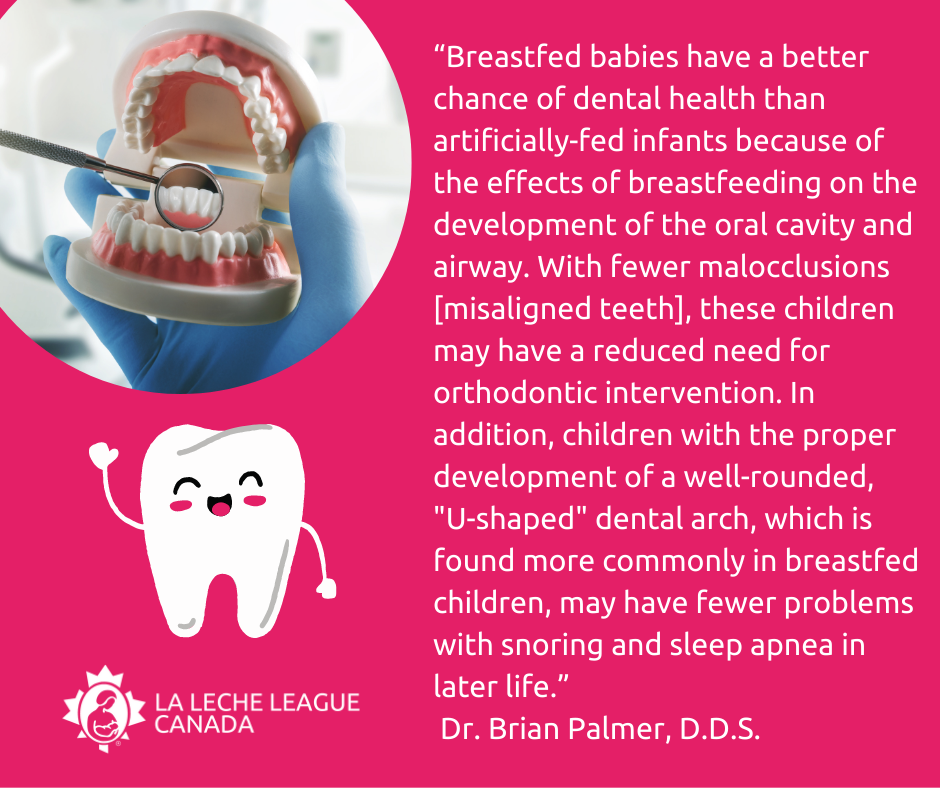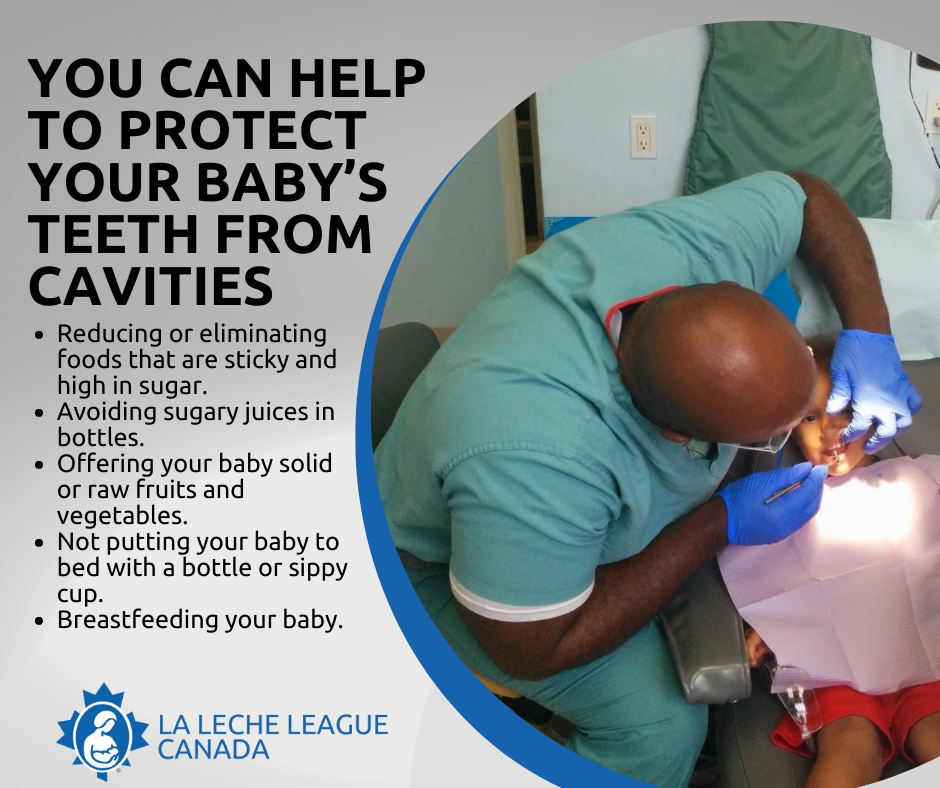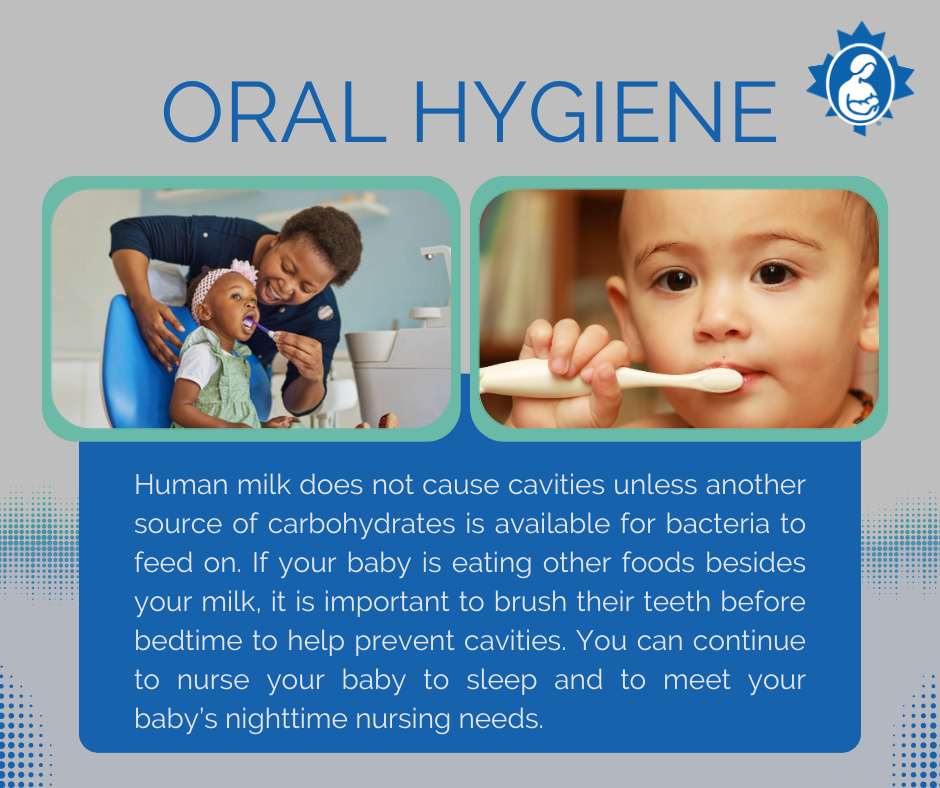
Importance of Breastfeeding for Infant Health
Health care providers in Canada are encouraged to support breastfeeding for two years and beyond.


Breastfeeding and Infant Oral Development
Breastfeeding is important for a baby’s oral development.
- Human milk contains calcium which is highly bioavailable. This means that babies absorb more calcium from human milk than from formula. Calcium helps to strengthen teeth.(10)
- Proteins in human milk can protect tooth enamel.(7)
- Human milk contains lactoferrin which helps to kill the bacteria that causes tooth decay.(9, 10)
- Babies who are exclusively nursing have a different pattern of sucking than babies who are exclusively bottle feeding. When your baby is latched efficiently, the breast is drawn deeply in the baby’s mouth. This deep latch supports and maintains the normal wide and shallow shape of the palate (the roof of the mouth). Artificial nipples, whether bottles or soothers, tend to push the palate into a higher, narrower V shape.(7, 8)
- The shape of your baby’s palate affects the external shape of your baby’s face and jaw as well as the shape of the dental arch. This, in turn, affects tooth spacing of both the baby and adult teeth. All of these factors together can affect speech production.
- A well-developed palate reduces crowding and the risk of dental caries.
- Well-spaced teeth are easier to clean and cleaner teeth are less likely to develop decay.
- Studies have shown that breastfed babies are less likely to have teeth alignment problems.(1, 7, 8, 10)

Parents often have questions about caring for their children’s teeth. They are particularly concerned if the child nurses to go to sleep or nurses throughout the night. It is helpful to know that there is no evidence that nighttime nursing itself causes childhood cavities.(9) Night feedings are important for most babies to get enough food. Some children get cavities. It is not because they breastfeed at night.
Many people confuse formula and human milk. Each reacts very differently with the teeth of babies. Human milk contains lactoferrin and secretory immunoglobulin A (IgA). Both help to prevent cavities. Formula does not contain these elements.(9, 10) The sugars and fermentable carbohydrates in formula can promote the dissolving of tooth enamel (the outer layer of teeth).(7) Human milk helps to remineralize teeth by depositing calcium and phosphorus into the enamel.(2, 9) This strengthens your baby’s teeth.

The bacteria Streptococcus mutans (S. mutans), and Lactobacillus contribute to a low pH environment in the mouth. Both produce acids which break down enamel and cause tooth decay.(4) Human milk has a neutral pH which helps to prevent the growth of these bacteria.
Preventing Dental Caries or Tooth Decay
There are a number of factors that contribute to tooth decay. These include the
- strength of the tooth surface
- presence of fermentable carbohydrates left on the teeth
- presence of bacteria such as Lactobacillus and S.mutans in the mouth.

The calcium in human milk is highly bioavailable and helps to strengthen your baby’s teeth. But strong teeth alone cannot prevent dental caries. Dental caries develop in the presence of fermentable carbohydrates – foods such as grains, baked goods, juice, sugary and sticky foods. Dental caries were rare before humans started growing and eating grains.(8) Grains introduced significant levels of fermentable carbohydrates into the human diet. Once foods other than human milk are introduced, your baby will likely be eating fermentable carbohydrates. Carbohydrates tend to stick to teeth. They interact with S. mutans and Lactobacillus and are metabolized by these germs which creates lactic acid which dissolves tooth enamel.(4, 7) This begins the process that causes tooth decay. One of the worst offenders is crackers, a common “baby food.”
Good Oral Hygiene (cleaning teeth regularly)
Breastfed babies can get dental caries. With good hygiene, childhood cavities can usually be avoided. Brushing and flossing removes fermentable carbohydrates from the teeth. This interrupts the fermentation process and the interaction with bacteria that results in tooth decay. Good oral hygiene begins very early and continues throughout life. It is important for you to care for your baby's gums and teeth right from the start. Use a soft cloth to wipe your baby’s mouth. Teeth brushing should start as soon as the first tooth erupts.(5)
Early Visits to the Dentist
Some children are more susceptible to dental caries for the reasons stated above or for other reasons. It is recommended to take a child to the dentist when the first tooth comes through or by their first birthday. Early visits will help your child feel comfortable at the dentist. Any issues can be caught early and managed. Dentists often recommend protective coatings and topical applications. These help to prevent tooth decay.

References
- Abate, A., Cavagnetto, D., Fama, A., Maspero, C., & Farronato, G. (2020). Relationship between Breastfeeding and Malocclusion: A Systematic Review of the Literature. Nutrients, 12(12), 3688. https://doi.org/10.3390/nu12123688
- Aly, A. A. M., Erfan, D., & Abou El Fadl, R. K. (2020). Comparative evaluation of the effects of human breast milk and plain and probiotic-containing infant formulas on enamel mineral content in primary teeth: an in vitro study. European Archives of Paediatric Dentistry : Official Journal of the European Academy of Paediatric Dentistry, 21(1), 75–84. https://doi.org/10.1007/s40368-019-00448-2
- Erickson, P. R., Mazhari, E. (1999). Investigation of the role of human breast milk in caries development. Pediatr Dent; 21:86–90.
- Forssten, S. D., Björklund, M., & Ouwehand, A. C. (2010). Streptococcus mutans, caries and simulation models. Nutrients, 2(3), 290–298. https://doi.org/10.3390/nu2030290
- Healthlink BC. (2021, June 30). Dental Care From Birth to 6 Months. https://www.healthlinkbc.ca/pregnancy-parenting/parenting-babies-0-12-months/baby-health/dental-care-birth-6-months
- Infant Feeding Joint Working Group. (2015, January 19). A joint statement of Health Canada, Canadian Paediatric Society, Dietitians of Canada, and Breastfeeding Committee for Canada. Nutrition for Healthy Term Infants: Recommendations from Six to 24 Months. https://www.canada.ca/en/health-canada/services/canada-food-guide/resources/infant-feeding/nutrition-healthy-term-infants-recommendations-birth-six-months/6-24-months.html
- Krol, D. M., and Whelan, K. (2023). Maintaining and Improving the Oral Health of Young Children. Pediatrics: 151(1). https://doi.org/10.1542/peds.2022-060417
- Palmer B. (1998). The Influence of Breastfeeding on the Development of the Oral Cavity: A Commentary. Journal of Human Lactation; 14:93-98. doi: 10.1177/089033449801400203
- Pitman, T., West, D., Wiessinger, D. (2014). Sweet Sleep: Nighttime and Naptime Strategies for the Breastfeeding Family.
- Riordan, J., & Wambach, K. (2010). Breastfeeding and Human Lactation.
- Jones and Bartlett Publishers. World Health Organization. Ending Childhood Dental Caries: WHO Implementation Manual (2020). https://www.who.int/publications/i/item/ending-childhood-dental-caries-who-implementation-manual
Updated 2024
